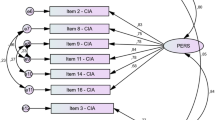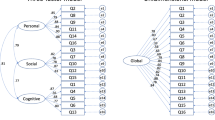Abstract
Background
The Clinical Impairment Assessment (CIA) is a measure of functional impairment secondary to eating disorder symptoms.
Aim
The aim of this study was to examine the psychometric proprieties of the Italian-language version of the CIA.
Methods
The tool was translated into Italian and administered to 259 Italian-speaking in- and outpatients with eating disorders and 102 healthy controls. The clinical group also completed the Eating Disorder Examination Questionnaire (EDE-Q) and the Brief Symptom Inventory (BSI).
Results
Confirmatory factor analysis revealed a good fit for the original three-factor structure. Internal consistency was high for both the global CIA and all subscale scores, and test–retest reliability was acceptable. The high correlation between CIA and EDE-Q and BSI confirmed the convergent validity of the instrument. T test indicated higher raw scores on CIA in patients with eating disorders than healthy controls, and a cut-off score of 16 on the CIA discriminated between eating disorder and general psychopathology scores. Finally, global CIA and subscale scores were significantly higher in patients who reported objective bulimic episodes, purging behaviours, and excessive exercising than in those who did not; in underweight than in not-underweight patients, and in inpatients than outpatients, confirming the good known-groups validity of the tool.
Conclusions
Overall, the study showed the good psychometric properties of the Italian version of the CIA, and validated its use in Italian-speaking eating disorder patients.
Level of Evidence
Level V, Descriptive study.
Similar content being viewed by others
References
WHOQOL (1995) The World Health Organization Quality of Life assessment (WHOQOL): position paper from the World Health Organization. Soc Sci Med 41(10):1403–1409
Ro O, Bang L, Reas DL, Rosenvinge JH (2012) The impact of age and BMI on impairment due to disordered eating in a large female community sample. Eat Behav 13(4):342–346. https://doi.org/10.1016/j.eatbeh.2012.05.010
Garratt AM, Ruta DA, Abdalla MI, Buckingham JK, Russell IT (1993) The SF36 health survey questionnaire: an outcome measure suitable for routine use within the NHS? BMJ 306(6890):1440–1444
Bohn K, Doll HA, Cooper Z, O’Connor M, Palmer RL, Fairburn CG (2008) The measurement of impairment due to eating disorder psychopathology. Behav Res Ther 46(10):1105–1110. https://doi.org/10.1016/j.brat.2008.06.012
Abraham SF, Brown T, Boyd C, Luscombe G, Russell J (2006) Quality of life: eating disorders. Aust N Z J Psychiatry 40(2):150–155. https://doi.org/10.1080/j.1440-1614.2006.01762.x
Adair CE, Marcoux GC, Cram BS, Ewashen CJ, Chafe J, Cassin SE, Pinzon J, Gusella JL, Geller J, Scattolon Y, Fergusson P, Styles L, Brown KE (2007) Development and multi-site validation of a new condition-specific quality of life measure for eating disorders. Health Qual Life Outcomes 5:23. https://doi.org/10.1186/1477-7525-5-23
Engel SG, Wittrock DA, Crosby RD, Wonderlich SA, Mitchell JE, Kolotkin RL (2006) Development and psychometric validation of an eating disorder-specific health-related quality of life instrument. Int J Eat Disord 39(1):62–71. https://doi.org/10.1002/eat.20200
Las Hayas C, Quintana JM, Padierna A, Bilbao A, Munoz P, Madrazo A, Urresti B, Cook EF (2006) The new questionnaire health-related quality of life for eating disorders showed good validity and reliability. J Clin Epidemiol 59(2):192–200. https://doi.org/10.1016/j.jclinepi.2005.06.005
Jenkins PE (2013) Psychometric validation of the Clinical Impairment Assessment in a UK eating disorder service. Eat Behav 14(2):241–243. https://doi.org/10.1016/j.eatbeh.2012.12.001
Vannucci A, Kass AE, Sinton MM, Aspen V, Weisman H, Bailey JO, Wilfley DE, Taylor CB (2012) An examination of the clinical impairment assessment among women at high risk for eating disorder onset. Behav Res Ther 50(6):407–414. https://doi.org/10.1016/j.brat.2012.02.009
Mahmoodi M, Moloodi R, Ghaderi A, Babai Z, Saleh Z, Alasti H, Naghashian F, Mohammadpour Z (2016) The Persian Version of Eating Disorder Examination Questionnaire and Clinical Impairment Assessment: Norms and Psychometric Properties for Undergraduate Women. Iran J Psychiatry 11(2):67–74
Martin J, Padierna A, Unzurrunzaga A, Gonzalez N, Berjano B, Quintana JM (2015) Adaptation and validation of the Spanish version of the Clinical Impairment Assessment Questionnaire. Appetite 91:20–27. https://doi.org/10.1016/j.appet.2015.03.031
Welch E, Birgegard A, Parling T, Ghaderi A (2011) Eating disorder examination questionnaire and clinical impairment assessment questionnaire:general population and clinical norms for young adult women in Sweden. Behav Res Ther 49(2):85–91. https://doi.org/10.1016/j.brat.2010.10.010
Reas DL, Ro O, Kapstad H, Lask B (2010) Psychometric properties of the clinical impairment assessment: norms for young adult women. Int J Eat Disord 43(1):72–76. https://doi.org/10.1002/eat.20653
Becker AE, Thomas JJ, Bainivualiku A, Richards L, Navara K, Roberts AL, Gilman SE, Striegel-Moore RH, Group HFS (2010) Validity and reliability of a Fijian translation and adaptation of the Eating Disorder Examination Questionnaire. Int J Eat Disord 43(2):171–178. https://doi.org/10.1002/eat.20675
Dahlgren CL, Stedal K, Ro O (2017) Eating Disorder Examination Questionnaire (EDE-Q) and Clinical Impairment Assessment(CIA): clinical norms and functional impairment in male and female adults with eating disorders. Nord J Psychiatry 71(4):256–261. https://doi.org/10.1080/08039488.2016.1271452
American Psychiatric Association (2013) Diagnostic and statistical manual of mental disorders, 5th Edition (DSM-5™). American Psychiatric Publishing, Arlington
Garner DM, Olmsted MP, Bohr Y, Garfinkel PE (1982) The eating attitudes test: psychometric features and clinical correlates. Psychol Med 12(4):871–878
Saporetti G, Sancini S, Bassoli L, Castelli B, Pellai A (2004) [Risk assessment for eating disorders in a high school: a study based on the Eating Attitudes Test 26]. Minerva Pediatr 56(1):83–90
Fairburn CG, Beglin SJ (2008) Cognitive behavior therapy and eating disorders. In: Fairburn CG (ed) Eating disorder examination questionnaire (EDE-Q 6.0). Guiford Press, New York, pp 309–313
Calugi S, Milanese C, Sartirana M, El Ghoch M, Sartori F, Geccherle E, Coppini A, Franchini C, Dalle Grave R (2016) The Eating Disorder Examination Questionnaire: reliability and validity of the Italian version. Eat Weight Disord. https://doi.org/10.1007/s40519-016-0276-6
De Leo D, Frisoni GB, Rozzini R, Trabucchi M (1993) Italian community norms for the Brief Symptom Inventory in the elderly. Br J Clin Psychol 32(Pt 2):209–213
Derogatis LR, Melisaratos N (1983) The Brief Symptom Inventory: an introductory report. Psychol Med 13(3):595–605
Derogatis LR, Cleary PA (1977) Factorial invariance across gender for the primary symptom dimensions of the SCL-90. Br J Soc Clin Psychol 16(4):347–356
Reas DL, Stedal K, Lindvall Dahlgren C, Ro O (2016) Impairment due to eating disorder pathology: Identifying the cut-off score on the Clinical Impairment Assessment in a clinical and community sample. Int J Eat Disord 49(6):635–638. https://doi.org/10.1002/eat.22517
Hilton A, Skrutkowski M (2002) Translating instruments into other languages: development and testing processes. Cancer Nurs 25(1):1–7
Hu LBP (1999) Cutoff criteria for fit indexes in covariance structure analysis: conventional criteria versus new alternatives. Struct Equ Model Multidiscip J 6(1):1–55. https://doi.org/10.1080/10705519909540118
Chen Y, Aranovich GL, Donohue MD (2007) Liquid-vapor density profiles from equilibrium limit of diffusion equation for interacting particles. J Colloid Interface Sci 307(1):34–39. https://doi.org/10.1016/j.jcis.2006.11.003
Hooper D, Coughlan J, Mullen M (2008) Structural equation modelling: guidelines for determining model fit. Electron J Bus Res Methods 6(1):53–60
Cronbach L (1951) Coefficient alpha and internal structure of tests. Psychometrika 16(2):297–334. https://doi.org/10.1007/BF02310555
McDonald R (1999) Test theory: a unified treatment. Lawrence Erlbaum Associated, Inc., Mahwan
Author information
Authors and Affiliations
Corresponding author
Ethics declarations
Conflict of interest
The authors declare that they have no conflict of interest.
Human and Animal rights statement
All procedures performed in studies involving human participants were in accordance with the ethical standards of the institutional and/or national research committee and with the 1964 Helsinki declaration and its later amendments or comparable ethical standards.
Informed consent
Informed consent was obtained from all individual participants included in the study.
Rights and permissions
About this article
Cite this article
Calugi, S., Sartirana, M., Milanese, C. et al. The clinical impairment assessment questionnaire: validation in Italian patients with eating disorders. Eat Weight Disord 23, 685–694 (2018). https://doi.org/10.1007/s40519-018-0477-2
Received:
Accepted:
Published:
Issue Date:
DOI: https://doi.org/10.1007/s40519-018-0477-2




